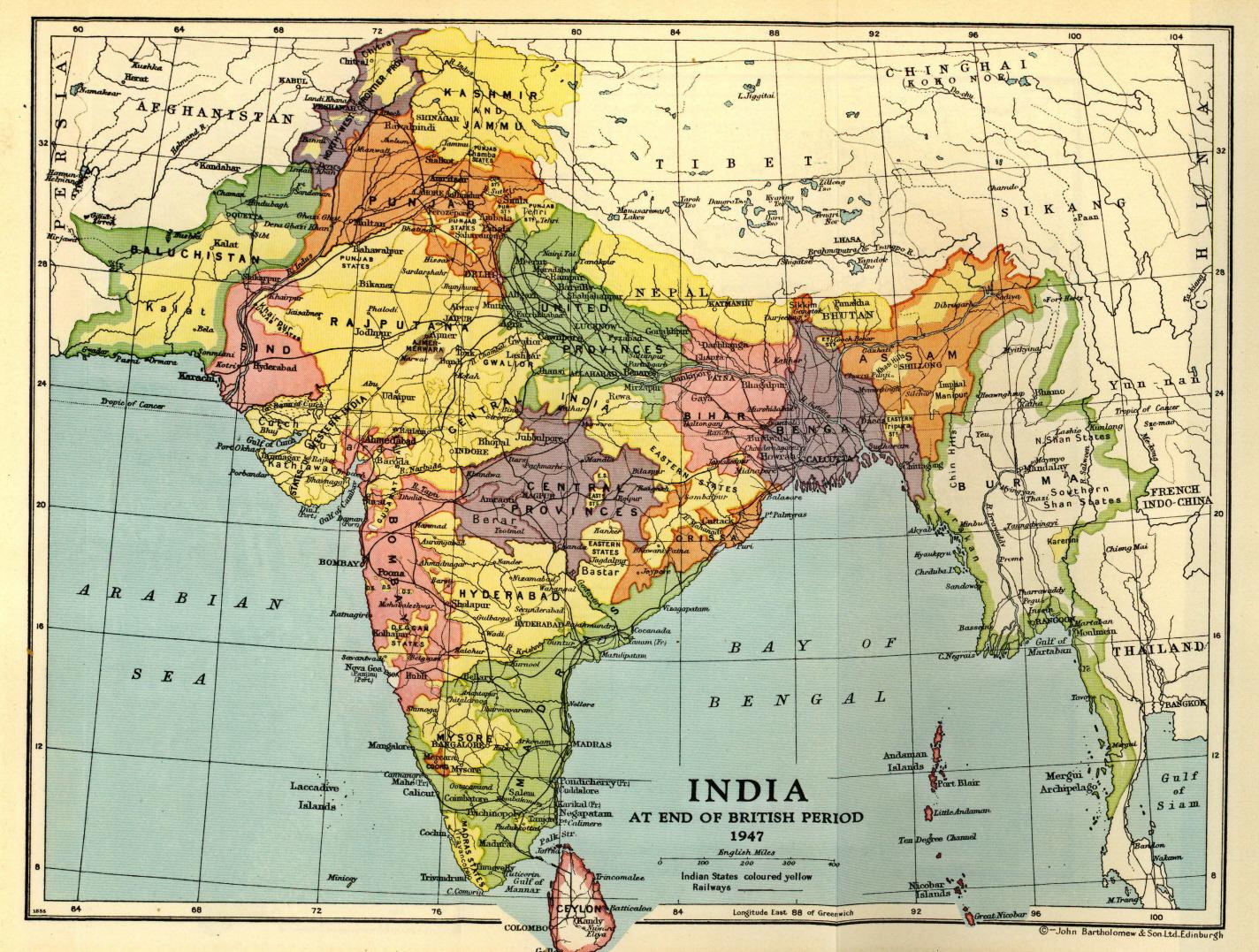India 1930 - 1947
The United Kingdom developed its empire during the 18th and 19th centuries, with the jewel in the crown for many people being India. British India comprised the entire sub-continent, including the territory now found in Pakistan and Bangladesh, and was known as the Indian Empire. It was not a homogeneous country, either in terms of race, religion or politics. British India contained people of the Muslim, Sikh, Hindu, Christian and Buddhist faiths. The many races extended from the Garhwali from the foothills of the Himalaya mountains to the Tamils from the south of India. British rule only applied in about two thirds of the country, the rest being Princely States that enjoyed a degree of autonomy.
The main provinces in British India were Madras, Bombay, Central Provinces, Punjab, United Provinces, Bengal, Assam, and Bihar and Orissa. The North West Frontier Province was another significant province. Burma was a province of India until 1937 when it was granted separation from India whilst remaining part of the British Empire.
NOTE: the term British India is used to apply to the pre-partition country that now comprises the current independent countries of Bangladesh, India and Pakistan.

The Indian Army
The Indian Army was a separate organisation to the British Army, although there was a close relationship between the two. The majority of the officers in the British Indian Army were British men who had joined the Army, trained at Sandhurst and then been admitted to the British Indian Army. In addition, the British Indian Army had Viceroy Commissioned Officers (V.C.Os.). These were experienced Indian soldiers who had served as Other Ranks and due to their ability and leadership, were granted a commission by the Viceroy of India. They served as platoon commanders (Jemadars) and second-in-command of companies (Subadars). Each battalion or regiment had one Subadar-Major, who was the most senior Indian officer in the unit and a key person for the British commanding officer to work with.
In the early 1920’s, Indian men were permitted to attend the Royal Military College, Sandhurst, and on commissioning they became King’s Commissioned Officers with the same status as their British colleagues. Then an Indian Military College was opened at Dehra Dun, with graduates being granted King’s Indian Commissioned Officers. A process of ‘Indianisation’ commenced in the 1930’s, with the intention of gradually replacing British Officers with Indian personnel. The Second World War hastened this process and brought about the recruitment of a large number of Emergency Commissioned Officers, both British and British Indian. Even so, at the end of the war, the highest rank held by a British Indian was that of Brigadier.
The Indian soldiers were all volunteers, a situation that persisted throughout the Second World War. They were drawn from various races and religions, although there was a preference for the martial races from the Punjab. As a result of the Indian Mutiny, regiments did not consist of soldiers from only one race or religion, so Punjabi Mussalman (Muslims) served in the Sikh Regiment and Sikhs served in the Punjab Regiments.
The main task of the Indian Army was to police the Indian Empire. As war loomed, the Indian government did sanction the possibility of Indian troops serving abroad, this being the basis of Force Heron based on the 4 Indian Division. By the end of the war, the Indian Army had grown to a force of about 2,500,000 men, making it the largest volunteer army ever raised. Indian troops served with distinction in France in 1940, Egypt, Libya, the Sudan, Abyssinia, Syria, Persia, Iraq, Malaya and Burma.
The British Army in India
Another legacy of the Indian Mutiny was the deployment of a large number of British Army units (mainly infantry) in India. These units were not part of the Indian Army, but came under operational command of the Indian Army. With the partition of British India on 15 August 1947, the British maintained a military presence in the two new countries for a short period. The last British Army unit to leave independent India was the 1 Bn. The Somerset Light Infantry, which left Bombay on 28 February 1948, with the British Headquarters, The Army in India closing on the same date. The last unit to leave Pakistan was the 2 Bn The Black Watch, which sailed from Karachi on 26 February 1948.
Structure of the Army in India
Pre-war, India Command was divided into four commands, each headed by a General or Lieutenant General, namely:
- Northern Command;
- Southern Command;
- Eastern Command;
- Western Command.
In late 1938, Western Command was downgraded to become the Western Independent District. Each command had a number of Districts under command, each being a Major General’s command. In April 1942, with the threat of Japanese invasion, Eastern Command and Southern Command were given a more operational focus and were redesignated as Eastern Army and Southern Army respectively. Also in April 1942, the Western Independent District was absorbed by Northern Command, which itself was redesignated as the North Western Army. In May 1942, a new command was established to control the central part of India. This meant that the higher level formations from May 1942 until the end of the war were:
- North Western Army;
- Southern Army;
- Eastern Army;
- Central Command.
With the end of the war, in 1946 the Armies reverted to being Commands, and British India moved back onto a peacetime setting with Central Command being disbanded. However, India quickly moved towards partition, with Northern Command becoming the Army Headquarters of the new Pakistan Army, and the other commands passing to the new Indian Army.

